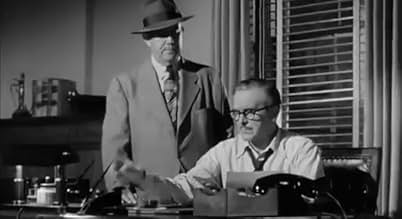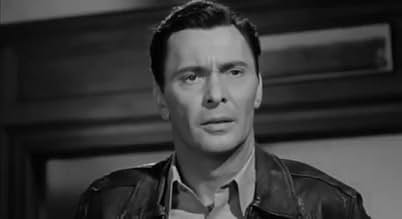Fed up with the rising crime rate in Miami, the police chief and leading members of the city council hire a former gangster who's gone straight to help eliminate the biggest crime syndicate ... Read allFed up with the rising crime rate in Miami, the police chief and leading members of the city council hire a former gangster who's gone straight to help eliminate the biggest crime syndicate in the city.Fed up with the rising crime rate in Miami, the police chief and leading members of the city council hire a former gangster who's gone straight to help eliminate the biggest crime syndicate in the city.
- Harry Dobey - Editor
- (uncredited)
- Charles Earnshaw
- (uncredited)
- Clifton Staley
- (uncredited)
- Simmons, Detective
- (uncredited)
- Gil Flagg
- (uncredited)
- Police Lieutenant
- (uncredited)
- Kingsford - Detective
- (uncredited)
- Gangster
- (uncredited)
Featured reviews
One of countless docu-noirs exposing every sort of crime ring in every major US city, this one even has a Florida senator chime in at the start, as well as the mandatory authoritative narration. Made on a low budget, it's pretty standard fare, but still manages to entertain. Sullivan ('The Gangster') is great as the former gangster who's still cold and callous when necessary, and Adler ('D.O.A.') played villains for breakfast, lunch and dinner. Jergens ('Armored Car Robbery') and Garland ('New Orleans Uncensored') play opposite roles, and esp Jergens is great as a bitter femme fatale just past her prime.
The directing by Fred F. Sears and cinematography by Harry Freulich is competent and occasionally inspired (there's a great shot of Garland when Sullivan first meets her inside his hotel room). They worked together on a number of movies, including other city/crime exposés like'Chicago Syndicate' and 'Inside Detroit'. Sears would even return to Miami a few years later for 'Miami Exposé'. All in all, while there's nothing under the sun here, and there are no real surprises (maybe that it's slightly more graphic than usual), it's a fast-paced and enjoyable movie if yer into this subgenre/corner of film noir.
Like all the other films in this cycle, "The Miami Story" takes a stock gangster plot that had been beaten to death in the 1930s and updates it to contemporary Florida. A committee of five Miami civic leaders seeks a way to bring down crime boss Tony Brill and his R&L Industries, the front for gambling and all sorts of vice rackets in Miami, so they call in ex-gangster Mick Flagg, who'd once been framed for murder by Brill and now lives incognito on an Indiana farm. Flagg is given a free hand and in no time at all is going through the motions of setting up a rival operation with Cuban backing, all to intimidate Brill, and ordering the police chief around as if he were Eliot Ness: "Give me some Cubans!" "I want the Biscayne Club closed town tonight!"
The police in this film do all kinds of things on Flagg's orders that they could easily have done on their own. At one point, Flagg has the cops install a TV camera in Brill's office at the Biscayne Club, all to capture private, incriminating conversations. However, TV cameras back then were huge bulky affairs so they can only stick one in an air conditioning shaft with a grill in front of it. As if the gangsters won't bother to investigate why no cool air will be forthcoming that night in the Miami heat. And when the cops watch the proceedings on little TV monitors outside the club, we see Brill and his men on the tiny screens exactly as they're shot in the film, in medium shots complete with pans and zooms. No high angle, no wide angle, nothing blurry, and no AC grill blocking the view! And they hear everything clearly even though no mike was seen installed.
Yes, the film is pretty far-fetched on all counts, never mind that they never even mention the mafia. Fortunately, the film is short (75 min.) and fast-paced and the cast is topped with four actors who really know how to sell this stuff. Tall, rugged western star Barry Sullivan plays Flagg and he's quite forceful and convincing, never one to hold back when a punch or a pistol-whipping are called for. Luther Adler, an old hand at film noir bad guys ("D.O.A.," "Kiss Tomorrow Goodbye"), plays Brill with old school charm and an indeterminate, vaguely Eastern European accent. Beverly Garland, also a veteran of "D.O.A." and later to shine in late '50s monster romps like "It Conquered the World" and "Curucu, Beast of the Amazon," plays Holly, an innocent girl caught up in the intrigue who takes sides with Flagg. Brassy blonde Adele Jergens, an underrated '50s B-movie queen, plays Gwen, Brill's all-knowing girlfriend and a cool customer in her own right.
The director is Fred F. Sears, who knew how to craft these things so that they never slowed long enough to give an audience a chance to question it. He and this film's producer, Sam Katzman, and writer, Robert E. Kent, re-teamed two years later for the similarly-themed "Miami Exposé," also reviewed on this site, which suffers from considerably weaker casting and even more ludicrous plotting.
Reek of Post-War Propaganda Platitudes to Placate and Control the Masses, it is a Wonder that Anyone at the Time didn't Barf on Their Britches at such Jingoism.
But Apparently Not, and it was a Common Opening to make Audiences Feel Safe and Sound in America.
In this one it is one of Miami's Senators.
Moving On...The Film is Slightly Above Average for its Type with some Stylish Blood-Letting and the Movie is Draped with Shadows.
Barry Sullivan is His Manly Self Punching and Assaulting Everyone in Sight, even Women, to Establish His Force as He Infiltrates Organized Crime in Miami.
B-Babe Beverly Garland, Plays a "Good Girl" in an Early Role and is Expressionistic Introduced to Sullivan with Face in Complete Shadow.
A Couple of Scenes Later Her Face is Beaten to a Pulp by Gangsters because..."She Clammed Up"...
Not Tolerated by the Mob even though this is Seaside.
This one is directed by Fred F. Sears and produced by the normally below-average Sam Katzman. It's actually pretty good, with nice performances by Barry Sullivan, Beverly Garland, Luther Adler, Adele Jergens, and John Baer.
The first thing we see is Senator George Smathers announcing that organized crime has been completely eradicated in Miami. This is how you know the movie is 70 years old.
In the film, a multibillion dollar crime syndicate is run by Tony Brill (Luther Adler). A citizens committee meets privately to figure out what to do.
A reformed mob boss, Mike Flagg, is located and brought in to pretend to move in on Brill's territory. He has a young son, whom he sends to live with friends.
Holly Abbott (Garland) has come to Miami to search for her sister Gwen (Jergens). Gwen is employed by Brill. Since Holly has befriended Flagg, Brill's associates beat her for information on his operation and plans.
Flagg has the police close Brill's gambling club. He retaliates by having Flagg's son (David Kasday) kidnapped.
Some interesting cinematography and exciting scenes. Others felt this film was above average. I think the cast certainly contributes to that, though for me it was an average crime story.
It is a middling effort, standard B flick with standard b&w photography and unremarkable acting. The script really stretches your suspension of disbelief, especially the decision to send former criminal Mick Flagg (Sullivan) into the lion's den, in order to cure the town of its crime pandemic.
One positive aspect about MIAMI STORY: 75' long.
Did you know
- TriviaEven though this was filmed while the Motion Picture Production Code (colloquially referred to as the Hays Code) was still being enforced, the filmmakers were able to push back on some of the limits, evidence that the Code was weakening in the 1950s. This film fairly graphically shows two men after being shot dead, shows a woman who had been badly beaten, and talks openly about prostitution and underage prostitution. The filmmakers most likely argued these "shocking" scenes would reiterate the pro-law-and-order message.
- GoofsMick Flagg obviously pulls his punches in several shots.
- Quotes
[first lines]
[as a montage starts, a voice can be heard narrating]
Narrator: In the years following World War II, organized crime in the United States grew to such proportions that it's scope was greater than the law enforcement agencies that tried to fight it.
[a shot of the U.S. Capitol Building can be seen]
Narrator: Finally, in the nation's capitol, the Senate Investigating Committee presented a new threat to gangland, and panic began to grip the overlords of crime.
[a montage of Miami can be seen playing]
Narrator: They sought a new central headquarters for their operation. The city where they felt they could be safe. They chose the Miami area, a vacation wonderland, a Mecca for tourists, who swelled the normal population of 600,000, to more than 2 million in the winter season. A city where the tough, honest police force was inadequate in size to protect the tremendous overflow of people. Then, out of sheer necessity, a way was found to crush crime in Miami. As Senator George Smathers, of the State of Florida relates...
- How long is The Miami Story?Powered by Alexa
Details
- Release date
- Country of origin
- Official sites
- Languages
- Also known as
- Secretos de Miami
- Filming locations
- Miami, Florida, USA(location shooting)
- Production company
- See more company credits at IMDbPro
- Runtime1 hour 15 minutes
- Color
- Aspect ratio
- 1.37 : 1
Contribute to this page


































